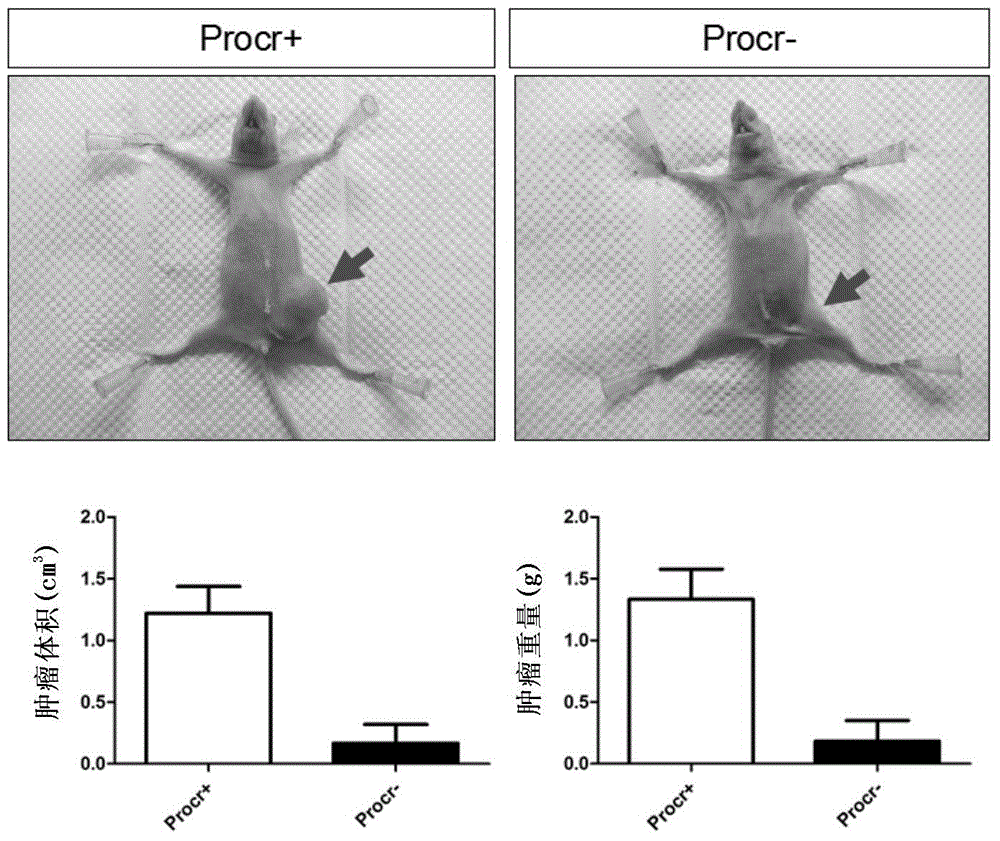Triple-negative breast cancer marker and applications of triple-negative breast cancer marker in diagnosis and therapy
A technology for triple-negative breast cancer and breast cancer, which is applied in the field of oncology and diagnosis, and can solve problems such as the lack of targeted treatment methods and the inability to develop drugs
- Summary
- Abstract
- Description
- Claims
- Application Information
AI Technical Summary
Problems solved by technology
Method used
Image
Examples
Embodiment 1
[0193] Procr is highly expressed in triple negative breast cancer samples and cell lines
[0194] 1.1 Immunohistochemical staining
[0195] Using the method of immunohistochemical staining, the expression of Procr was detected in the four human breast cancer subtypes.
[0196] Specific steps: Collect tissue sections of 311 clinical samples of human breast cancer.
[0197] The results of immunohistochemical staining are as follows figure 1 As shown, in triple-negative breast cancer samples, about 86% were Procr positive (n=113); while in LummalA, LuminalB, Her2 positive breast cancer, the Procr positive rate was significantly lower, respectively (about 14%, n= 79), (about 12%, n=58) and (26%, n=61).
[0198] This result shows that Procr is widely and highly expressed in triple-negative breast cancer and can be used as a molecular marker for the diagnosis of triple-negative breast cancer.
[0199] 1.2 Quantitative PCR
[0200] Real-timeQPCR method was used to detect different subtypes of ...
Embodiment 2
[0203] Procr-positive breast cancer tumor cells are more tumorigenic
[0204] Specific steps: After the MMTV-Wnt1 mice that had formed breast tumors were sacrificed, their tumor tissues were taken out and cut into pieces, and the tissue pieces were digested with collagenase. The digested mammary glands are treated with red blood cell lysate and then trypsinized to obtain single cells. With the help of a flow cytometer, use anti-Ter119-FITC, anti-CD31-FITC, anti-CD45-FITC antibodies to remove blood system-related components in the breast, and use anti-CD29-APC and anti-CD24-PE- Cy7 distinguishes breast tumor epithelial cells, and then uses anti-Procr-PE to obtain Procr positive and Procr negative breast tumor epithelial cells.
[0205] The sorted Procr negative and positive cells were injected into the fourth pair of mammary glands on the right side of female nude mice at 3 weeks. Observe the formation of the tumor after 3 months.
[0206] The result is image 3 Shown. Procr-posit...
Embodiment 3
[0210] Procr-positive normal mouse mammary stem cells show typical epithelial-mesenchymal transformation properties
[0211] Specific steps: After euthanizing the adult female mouse, take out the breast tissue and cut it into pieces, and digest the tissue block with collagenase. The digested mammary glands are treated with red blood cell lysate and then trypsinized to obtain single cells. With the help of a flow cytometer, use anti-Ter119-FITC, anti-CD31-FITC, anti-CD45-FITC antibodies to remove blood system-related components in the breast, and use anti-CD29-APC and anti-CD24-PE- Cy7 distinguishes the basal cells of the breast epithelium, and then uses anti-Procr-PE to obtain Procr-positive and Procr-negative breast epithelial cells.
[0212] The obtained Procr-positive and Procr-negative cells were subjected to RNA sequencing. Through cluster analysis, it was found that the Procr-positive breast stem cells had obvious epithelial-mesenchymal transition characteristics.
[0213] Su...
PUM
 Login to View More
Login to View More Abstract
Description
Claims
Application Information
 Login to View More
Login to View More - R&D
- Intellectual Property
- Life Sciences
- Materials
- Tech Scout
- Unparalleled Data Quality
- Higher Quality Content
- 60% Fewer Hallucinations
Browse by: Latest US Patents, China's latest patents, Technical Efficacy Thesaurus, Application Domain, Technology Topic, Popular Technical Reports.
© 2025 PatSnap. All rights reserved.Legal|Privacy policy|Modern Slavery Act Transparency Statement|Sitemap|About US| Contact US: help@patsnap.com



